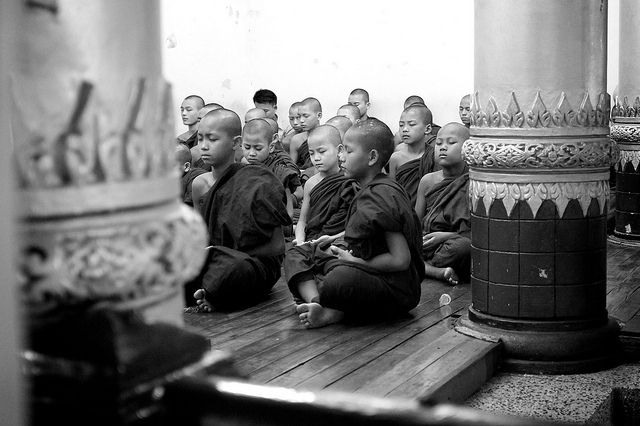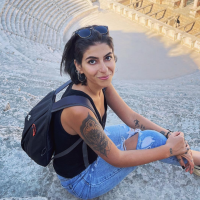Yesterday marked my third session with my teacher in Dharamsala, India.
Although he is basically giving me teachings, he doesn’t like me to label them as such. He likes to call our sessions “Dharma talks” or “a conversation between two persons.”
After crossing paths with him, I undoubtedly believe now that studying with a Buddhist monk outweighs reading any spiritual book. I think Buddhists or Buddhist practitioners should try to dedicate a stage in their lives where they can get to live with monks or at least study with them.
The main reason is because spirituality worldwide is tending to become “commercialized.” The latest trend nowadays is to open meditation centers or write a book about the secret to happiness. Sadly, we don’t necessarily know where these authors or meditation “teachers” got their information or what they really know and have experienced.
As my teacher told me in our second session, if you wish to know more about Buddhism, get a book by His Holiness, The Dalai Lama, or books written by Rinpoches. They are the only ones who can offer us a true understanding of Buddhism.
As we know, meditation plays an immense role in Buddhism. Therefore, we should be careful from who or where we are learning it. Although I have been meditating for quite some years now, my teacher mentioned some points I wouldn’t have found on the internet or in a book.
As per our conversation, I have written down the instructions exactly the way he offered them. Below are five crucial points before starting our meditation:
1. The place of our meditation.
“We should always meditate in a clean room. Before sitting in meditation, clean the floor from any dust or dirt. The energy in the room should be pure.”
2. The cushion we should sit on.
“We should sit on one rectangular or circular cushion. It shouldn’t be very small; it should be big enough to cover the space of our whole body. A cushion of two to three inches is enough. Now on top of that cushion, we should place another small one that should cover only the space of our behind. We do this because sitting on one cushion will create an idnentation after couple of minutes. Therefore, our body will go lower towards the floor, allowing the back to lean forward for comfort.
However, placing two cushions will keep our back straightened.”
3. Our body parts.
Legs: “Legs can be fully crossed or half crossed. It depends on what makes you feel comfortable. If you feel any pain during meditation, try to stay in place, do not move; this is how the ancients used to meditate. The body will hurt, but the mind will not. However, if you have problems with your knees, or legs, you may stretch the leg that is hurting you for a little time then go back to sitting in meditation.”
Hands: “The hands should be placed in a comfortable way. The most comfortable way is to lay them on our lap. We must place the right one above the left and gently touch our thumbs together.
Our hands should face our belly-button. After 10 to 15 minutes we might feel warmth between our belly-button and our hands––no need to be scared if it happens. Most importantly, we should keep distance between our arms and body; they shouldn’t touch.”
Back: “Our spinal cord should be perfectly straight. The two cushions we’re sitting on will help in that procedure.”
Head: “The head shouldn’t completely follow our back. We must bow it down a little bit. But not too much though or else we might fall asleep (laughs).”
Eyes: “In the West, they teach to fully close the eyes, but it’s wrong. Closing eyes creates darkness and mental dullness. It’s easier for the mind to create mental images when the eyes are closed. The right way is to keep them ‘quarter-opened.’ The vision should be somewhat unfocused and looking down.”
Lips: “As written in the old books, our lips should stay natural. Do not squeeze them, do not open them wide; keep them the way they are.”
Tongue: “Our tongue should touch our upper teeth and gum. It will become like a little curve heading upwards. There are two reasons for this: One, it keeps saliva away. When we place our tongue in that position, the way of the saliva is blocked. And you don’t want saliva being ejected from your mouth when you’re meditating, right? (laughs).
Two, placing the tongue like this will make our breathing gentler. When our tongue is normally placed in our mouth, our breathing tends to be heavy and strong. We should make that smoother and the right way is curving our tongue upwards.”
4. Our breathing.
“Our breath should go all the way down to our belly; fully inhale and fully exhale. Breathing should happen from the belly and not from the chest; breathing from the chest is tiring. For a better breathing, you may close one nostril, inhale from the other. Then close the other and exhale from the one opened.”
5. Practicing.
“Buddhists monks and nuns practice six times a day: Morning, afternoon, evening, night, midnight and dawn. But people leading a regular life may not be able to practice this much. However, two to three times a day is good. It doesn’t matter if you sit for half an hour or one hour. What matters is that you meditate.”
These tips from a qualified meditation master are already helping my practice. Hopefully they will help you too!
Relephant:
How to Meditate: The Dathun Letter, via Chögyam Trungpa Rinpoche.
~
Author: Elyane Youssef
Editor: Travis May
Photo: Flickr/a(-_-)c











Read 1 comment and reply